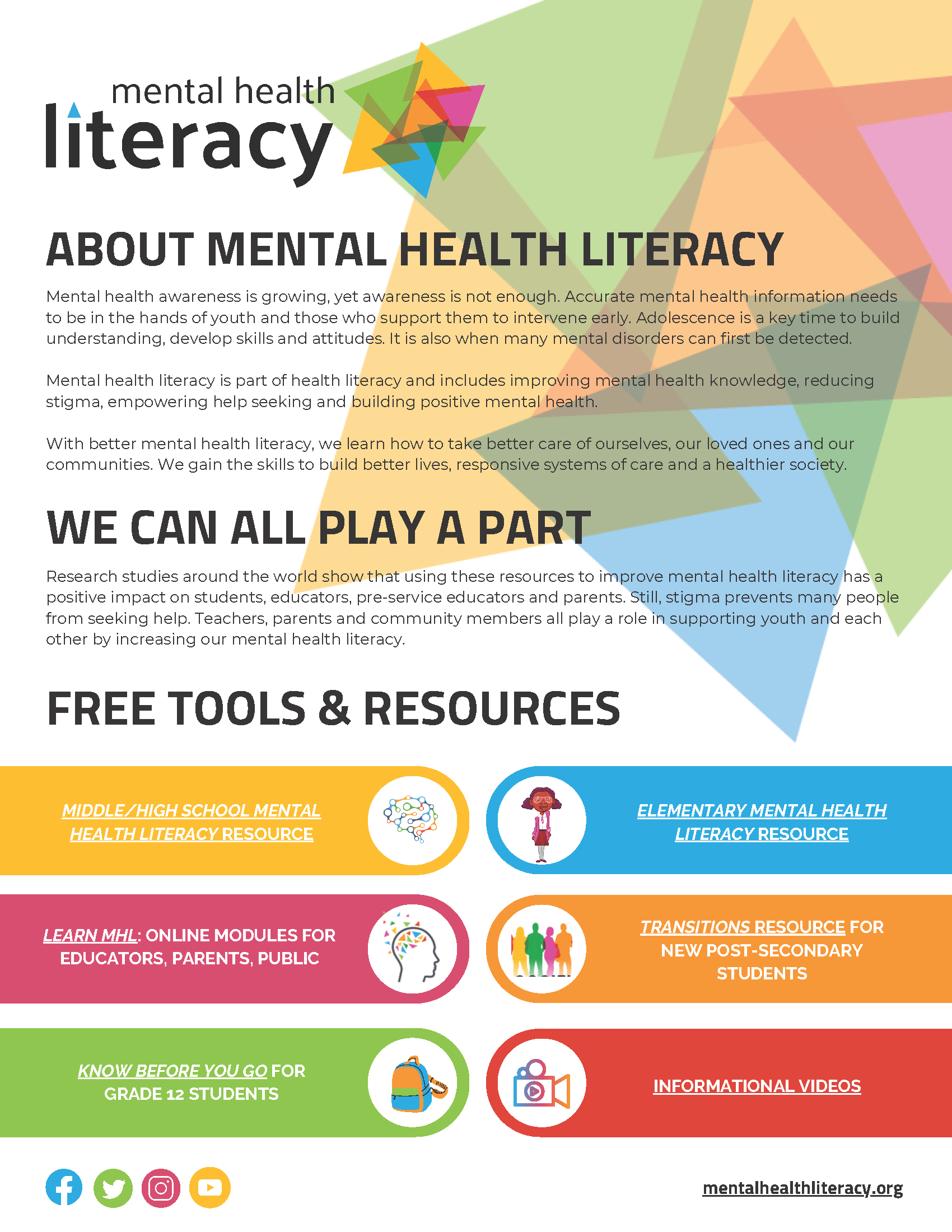Effective Strategies For Mental Health Literacy Education

Table of Contents
Understanding the Importance of Early Intervention and Prevention in Mental Health Literacy Education
Early intervention is paramount in mitigating the impact of mental health conditions. The earlier we identify and address issues, the better the chances of positive outcomes.
Recognizing the Signs and Symptoms of Common Mental Health Conditions
Mental health conditions often present with subtle signs that can be easily overlooked. Early warning signs of depression might include persistent sadness, loss of interest in activities, and changes in sleep or appetite. Anxiety symptoms can manifest as excessive worry, restlessness, and difficulty concentrating. Education plays a crucial role in equipping individuals with the ability to recognize these symptoms:
- Depression Symptoms: Changes in sleep patterns (insomnia or hypersomnia), significant weight loss or gain, fatigue or loss of energy, feelings of worthlessness or guilt, recurrent thoughts of death or suicide.
- Anxiety Symptoms: Excessive worry, restlessness or feeling keyed up or on edge, difficulty concentrating, irritability, muscle tension, sleep disturbances.
By understanding these symptoms, individuals can seek help promptly, reducing the severity and duration of the condition. Furthermore, Mental Health Literacy Education helps to reduce stigma surrounding mental illness, encouraging open conversations and early intervention.
Promoting Help-Seeking Behaviors
Despite the availability of support, many individuals hesitate to seek professional help. Stigma, lack of awareness about available resources, and financial constraints are significant barriers. Mental Health Literacy Education needs to address these barriers directly:
- Highlighting the benefits of early intervention: Early treatment significantly improves prognosis and reduces the long-term impact of mental health conditions.
- Providing information about support services: Listing helplines, online resources, and mental health professionals can empower individuals to take the first step towards recovery.
- Addressing financial barriers: Discussing affordable options and insurance coverage can remove financial obstacles to accessing care.
By creating a supportive environment and providing accessible resources, we can encourage help-seeking behaviors and facilitate early intervention.
Developing Effective Mental Health Literacy Curriculum and Training Programs
Developing effective Mental Health Literacy Education programs requires a multifaceted approach that considers diverse audiences and utilizes engaging teaching methods.
Curriculum Design for Diverse Audiences
Effective curricula must be tailored to different age groups and cultural backgrounds:
- Age-Appropriate Education: Children need age-appropriate information presented in an accessible and engaging format. Adolescents require education focusing on peer pressure, social media, and identity development. Adults benefit from information on managing stress, building resilience, and seeking support.
- Culturally Sensitive Approaches: Curricula must consider the unique cultural perspectives and experiences that shape individuals' understanding of mental health. Using culturally appropriate examples and language is crucial.
- Interactive Teaching Methods: Engaging teaching methods, such as role-playing, group discussions, and interactive games, can foster a deeper understanding and enhance retention.
Teacher Training and Professional Development
Educators play a vital role in Mental Health Literacy Education. Equipping them with the necessary knowledge and skills is crucial:
- Comprehensive Teacher Training: Training programs should cover the identification of mental health conditions, communication strategies, and available resources.
- Ongoing Professional Development: Regular updates on best practices and new developments in mental health are essential for maintaining the quality of education.
- Creating a Supportive Environment: Training should focus on creating safe and supportive classroom environments where students feel comfortable discussing mental health issues.
Investing in teacher training is a crucial step in ensuring that Mental Health Literacy Education reaches its full potential.
Leveraging Technology and Innovative Approaches in Mental Health Literacy Education
Technology offers exciting opportunities for expanding the reach and impact of Mental Health Literacy Education.
Utilizing Online Resources and Digital Platforms
Online platforms, apps, and virtual reality can offer convenient and accessible ways to learn about mental health:
- Online Learning Platforms: MOOCs and online courses can provide comprehensive information about various mental health conditions and coping strategies.
- Mental Health Apps: Apps offering self-assessment tools, relaxation techniques, and access to support services can improve access to care.
- Virtual Reality: VR technology can be used to simulate real-life scenarios, helping individuals develop coping mechanisms and reduce anxiety.
Integrating Mental Health Literacy into Existing Educational Settings
Integrating Mental Health Literacy Education into existing settings is essential for creating a holistic approach to mental well-being:
- School Mental Health Programs: Integrating mental health education into school curricula can help identify and support students struggling with mental health issues.
- Workplace Wellness Programs: Mental health programs in the workplace can reduce stress, improve productivity, and create a supportive work environment.
- Community Initiatives: Community-based programs can provide education and support to individuals across different age groups and backgrounds.
Investing in Effective Mental Health Literacy Education for a Healthier Future
Effective Mental Health Literacy Education hinges on early intervention, well-designed curricula, and the strategic use of technology. By fostering open conversations, providing accessible resources, and empowering individuals with knowledge, we can create healthier individuals, families, and communities. Invest in your community's well-being by supporting and promoting effective Mental Health Literacy Education initiatives today!

Featured Posts
-
 Une Boulangerie Normande Offre Son Poids En Chocolat Au Premier Ne
May 02, 2025
Une Boulangerie Normande Offre Son Poids En Chocolat Au Premier Ne
May 02, 2025 -
 Dundee Man Jailed For Sexual Assault Graeme Sounes Sentencing
May 02, 2025
Dundee Man Jailed For Sexual Assault Graeme Sounes Sentencing
May 02, 2025 -
 When Is Sabrina Carpenter Coming To Fortnite Confirmed Date And Time
May 02, 2025
When Is Sabrina Carpenter Coming To Fortnite Confirmed Date And Time
May 02, 2025 -
 Credible Evidence Links Former Uk Mp Rupert Lowe To Toxic Office Environment
May 02, 2025
Credible Evidence Links Former Uk Mp Rupert Lowe To Toxic Office Environment
May 02, 2025 -
 Hazing Scandal 11 Syracuse Lacrosse Players Avoid Kidnapping Charges
May 02, 2025
Hazing Scandal 11 Syracuse Lacrosse Players Avoid Kidnapping Charges
May 02, 2025
Latest Posts
-
 10 Film Noir Classics You Need To See
May 10, 2025
10 Film Noir Classics You Need To See
May 10, 2025 -
 Police Investigating Racially Motivated Stabbing Death
May 10, 2025
Police Investigating Racially Motivated Stabbing Death
May 10, 2025 -
 Bert Kreischers Netflix Specials His Wifes Reaction To His Sex Jokes
May 10, 2025
Bert Kreischers Netflix Specials His Wifes Reaction To His Sex Jokes
May 10, 2025 -
 Investigation Underway After Womans Racist Unprovoked Stabbing
May 10, 2025
Investigation Underway After Womans Racist Unprovoked Stabbing
May 10, 2025 -
 Death After Racist Stabbing Womans Unprovoked Attack
May 10, 2025
Death After Racist Stabbing Womans Unprovoked Attack
May 10, 2025
